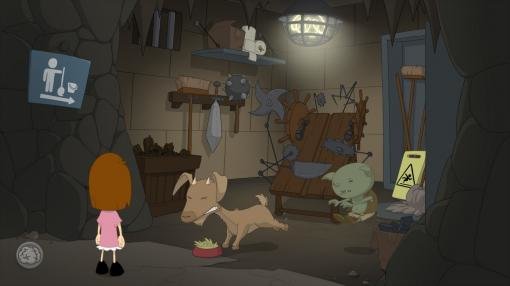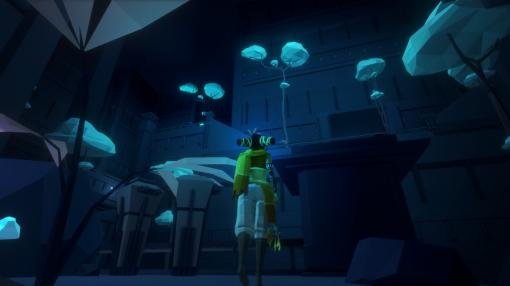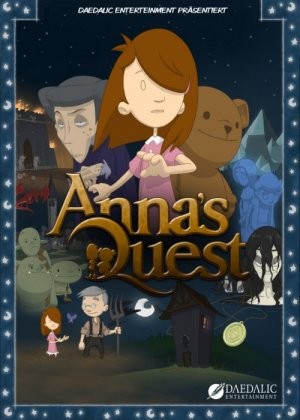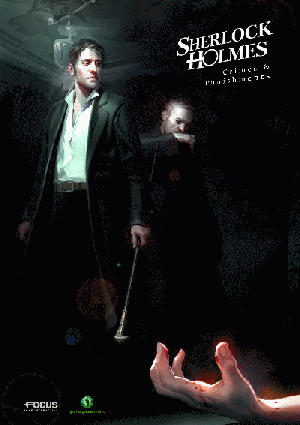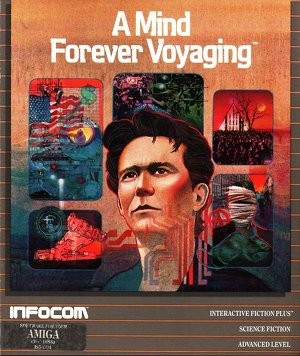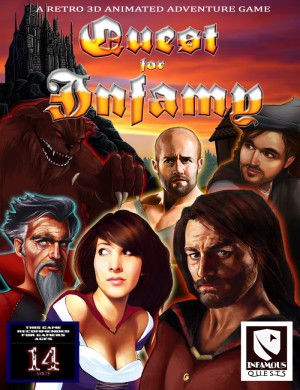Daedalic Preview: Anna’s Quest and AER archived preview
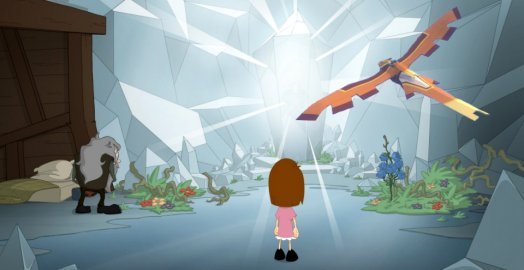
Year after year, Daedalic proves themselves as experts in “traditional” point-and-click adventure games—but as we saw at the recent Game Developer’s Conference, they have something new up their sleeves as well. Read on for a sneak peek of the classic-style adventure Anna’s Quest, which will be out in a few weeks, and a birds-eye view of AER, an exploration-heavy game still in early development.
Anna's Quest
In 2012, indie developer Krams Design released Anna’s Quest: Volume 1, the first in a planned series of fairy tale-inspired adventures about a girl with telekinetic powers. AG’s reviewer gave it four stars, praising its off-kilter world and strong-minded young heroine, but the follow-up episodes never materialized. That’s about to change thanks to Daedalic, who teamed up with the game’s designer Dane Krams to recreate Anna’s Quest as a full-length adventure.
The new game starts out the same way as the original: Anna ventures into the deep, dark forest in search of a cure for her grandfather, who has suddenly fallen ill. In the woods, she’s kidnapped by a witch who knows about Anna’s telekinetic powers, and is imprisoned in a tower. Though some text has been tweaked, animations added, and the voice actor for Anna’s teddy bear sidekick Ben (previously known as Ted) recast, the early gameplay follows the original closely.
Anna’s Quest has a distinct fairy tale feel, with many references to stories of the Brothers Grimm, Hans Christian Andersen, and other classics. The game begins with “Once upon a time…” narration and many of the characters and scenarios Anna encounters are taken straight from fairy tales, such as helping a group of musicians get into a cabin occupied by thieves as in the “Town Musicians of Bremen,” and discovering the three bears in a sticky situation. The overarching quest involves finding a cure for Anna’s grandfather and making it back home, but in her travels Anna will uncover a bigger story that relates to her newfound telekinetic powers.
At GDC, Daedalic demoed a section of chapter 4 (of 6), where Anna is trapped in a dungeon guarded by trolls. Here, some of the game’s dark humor comes out through a public execution set up like a game show, a puzzle involving a snotty napkin, and a curious torture device known as the human blender (use your imagination). In general, Daedalic says the humor is subtler and the puzzles less far-fetched than in their Deponia games, but from what I saw, both the writing and the puzzle solutions have the potential for laughs.
Gameplay involves traditional inventory and dialogue puzzles. In the chapter 4 demo, for example, Anna needed to get through a door guarded by a very thirsty troll, which required her to figure out how to mix him a drink with four ingredients (something sweet, something creamy, something juicy, and something special). There will also be telekinesis puzzles that allow her to obtain items or make things happen from afar. All this is done in colorful cartoon art that has been animated by several members of the Deponia team.
I only saw a small snippet, but in many ways Anna’s Quest reminds me of King’s Quest, what with its mission to save a dying parent (KQIV), its chapter set amongst trolls (KQVII), and its fairy tale homages. We’ll find out if this is an apt comparison on July 2, when Anna’s Quest releases for PC, Mac, and Linux.
AER
And now for something completely different, the other game Daedalic showed me at GDC is AER, a “mystical exploration game” coming in 2016. Developed by a small Swedish team, Forgotten Key, AER is like nothing we’ve seen from the German publisher thus far.
In AER, you play as a girl named Auk who has the ability to transform into a bird. Even though Auk’s world is comprised of aerial, floating islands, this ability is rare among her people. An ancient priestess who had the same ability tried to save the world but didn’t quite manage it, resulting in the world being split up into islands in the sky. Now Auk must follow in her footsteps by going on a pilgrimage, which will expand in scope as she uncovers details about the cosmic evil that threatens her world. This journey will take her to the Land of the Gods, to explore temples left behind by an ancient civilization.
The game will begin with an introduction to the premise and basic game mechanics, but very early you’ll be set free to explore the open aerial world however you choose. The game is being developed for consoles as well as computers, so it makes use of gamepad controls. (PC/Mac/Linux users will also have the option of keyboard and mouse, but as with many 3D games there won’t be a mouse-only option.) On land, Auk runs like any human, but with the press of a button you can jump into the sky, transform into a bird, and fly around the island you’re currently exploring or travel to other islands. In my hands-on time with the demo, I found running easier than flying; players unaccustomed to action games can expect a learning curve. That said, the controls are still being fine-tuned and the developers seem anxious to create an intuitive experience so players can lose themselves in exploration.
The prototype I saw was far from final, but I’m told AER’s gameplay will involve traversing the islands, flying around, exploring ancient temples and attempting to make contact with the gods who inhabit them, talking to the “spirit animals” that reside on the islands, and gathering snippets of what Forgotten Key calls a “modular story” scattered around the open world. There will also be some stealth elements as you sneak around an ancient guardian lurking in the temples, and a lantern that can be used to illuminate dark areas, interact with the ancient world, and reveal memories that have been frozen in time—all of which will presumably enhance your understanding of the story. Details about actual puzzles and specific gameplay are vague at this point, but the set-up certainly is intriguing.
“When we started out, instead of making a mechanic and building the game around it, we were focused on making a game that’s about exploration. And then we also wanted this narrative component about letting the player go through a story, living out the fantasy of saving the world,” Forgotten Key’s Robin Hjelte explained. “So we took these elements and tried to design around them. We designed this open world, we designed this free flying mechanic that lets you go wherever you want to, the modular story; everything is built around this sense of exploration.”
Befitting a game that gives you the freedom of flight, AER will put few restrictions on where you go and what you do. The entire world will be accessible from the beginning, as opposed to a place you can only explore one location at a time, as in Journey (an obvious influence). You’ll get some guidance as to tasks that need to be completed, but these are non-linear and can be done in any order you please. The graphics, too, are a work in progress, but one of the goals is a “playful” exterior, so you can fly around and enjoy the scenery even when you’re not pursuing the story, seeing how the natural world reacts to Auk’s presence. In contrast, the temples will be rundown ancient ruins, themed to reflect the gods that reside there and events of the past. While a map will likely be available to help navigate, the developers hope to tightly integrate this so as not to clutter the on-screen interface or break the player’s immersion in Auk’s world. Auk will have a journal, too, to help keep track of where she’s been and what she’s done.
As artifacts of an ancient civilization, the temples will initially be “slumbering” and Auk’s interaction within the temples will “wake them up,” a concept that reminds me a lot of certain orb-activated dungeons in Final Fantasy. The developers have also been heavily influenced by the Zelda games, Wind Waker in particular. So is AER actually an adventure game? It will apparently be story-heavy and combat-free, but when Daedalic announced the game in January they referred to it as “a genre mix between action adventure and flight exploration”—clearly, they’re hoping AER will spark interest beyond their usual audience. That said, if you love getting lost in an unusual world and don’t mind a little running—and flying—mixed in with your exploration, this is a game worth keeping an eye on.


